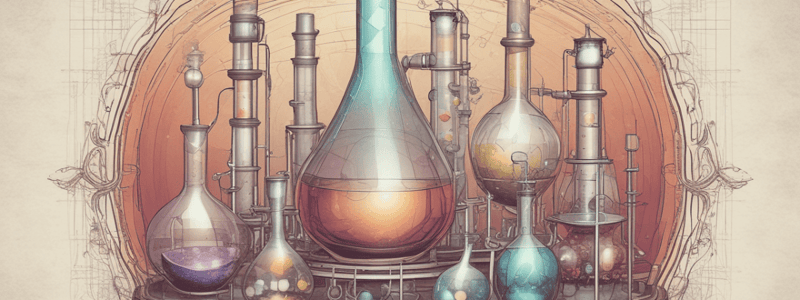Podcast
Questions and Answers
What does the empirical formula of a compound indicate?
What does the empirical formula of a compound indicate?
- The percentage of each element present in the compound
- The exact number of atoms of each element present in the compound
- The simplest whole number ratio in which the atoms of elements are present (correct)
- The molecular mass of the compound
What is the first step in calculating the empirical formula of a compound from its percentage composition?
What is the first step in calculating the empirical formula of a compound from its percentage composition?
- Assume a certain mass of the compound and calculate the mass of each element (correct)
- Divide the percentage of each element by its molar mass
- Calculate the molecular mass of the compound
- Find the ratio of the elements
What is the purpose of dividing the smallest number into each number when calculating the empirical formula?
What is the purpose of dividing the smallest number into each number when calculating the empirical formula?
- To find the molecular mass of the compound
- To find the percentage of each element
- To find the exact number of atoms of each element
- To simplify the ratio of the elements (correct)
Why is the molar mass of oxygen (O) used instead of oxygen gas (O₂) when calculating the empirical formula of copper oxide?
Why is the molar mass of oxygen (O) used instead of oxygen gas (O₂) when calculating the empirical formula of copper oxide?
What is the empirical formula of the compound with the molecular formula Fe₃O₄?
What is the empirical formula of the compound with the molecular formula Fe₃O₄?
What is the percentage of nitrogen in ammonium manganate (NH₄MnO₄)?
What is the percentage of nitrogen in ammonium manganate (NH₄MnO₄)?
What is the balanced equation for the reaction of methane (CH₄) with oxygen?
What is the balanced equation for the reaction of methane (CH₄) with oxygen?
If 6.5 moles of MnS fully react, how many moles of O₂ are consumed?
If 6.5 moles of MnS fully react, how many moles of O₂ are consumed?
What is the volume of CO₂ produced when 45g of carbon is burned at s.t.p?
What is the volume of CO₂ produced when 45g of carbon is burned at s.t.p?
What is the volume of Cl₂ produced at standard temperature and pressure?
What is the volume of Cl₂ produced at standard temperature and pressure?
How many molecules of potassium dichromate are present in 0.02 moles?
How many molecules of potassium dichromate are present in 0.02 moles?
Flashcards are hidden until you start studying
Study Notes
Empirical Formulas
- The empirical formula of a compound indicates the simplest whole number ratio of elements present in the compound.
- To calculate the empirical formula, analyze the percentage of each element in the compound.
- Example: A compound contains 52.17% carbon, 13.04% hydrogen, and 34.79% oxygen. The empirical formula is C₂H₆O.
Calculating Empirical Formulas
- Calculate the moles of each element using the mass and molar mass (Mr).
- Find the ratio of moles by dividing the smallest number into each number.
- Example: Calculate the empirical formula of copper oxide using reactants and products.
Molecular Formulas
- The molecular formula indicates the actual number of atoms of each element present in a molecule.
- To find the molecular formula, both the empirical formula and molar mass (Mr) are needed.
- Example: Glucose has an empirical formula of CH₂O and an Mr of 180. The molecular formula is C₆H₁₂O₆.
Stoichiometry
- Stoichiometry involves the calculation of reactants and products in a chemical reaction.
- Example: Calculate the mass of MgO formed when 18g of magnesium is burned to produce magnesium oxide.
- Example: Calculate the volume of CO₂ produced when 45g of carbon is burned at s.t.p.
Balancing Chemical Equations
- Balancing chemical equations involves adjusting the coefficients of reactants and products to satisfy the law of conservation of mass.
- Example: Balance the equation for the combustion of methane in oxygen.
- Example: Balance the equation for the reaction of MnS with oxygen.
Calculations Based on Balanced Equations
- Calculate the moles of reactants and products using the balanced equation.
- Example: Calculate the moles of O₂ consumed and the moles of SO₂ formed in the reaction of MnS with oxygen.
- Example: Calculate the mass of MgO formed when 18g of magnesium is burned to produce magnesium oxide.
% Composition by Mass
- Calculate the percentage of an element in a compound using the mass of the element as a percentage of the total mass of the compound.
- Example: Calculate the percentage of nitrogen in ammonium manganate (NH₄MnO₄).
Structural Formulas
- The structural formula of a compound indicates the arrangement of atoms within a molecule.
- Example: The structural formula of ethane is CH₃CH₃.
Balancing Chemical Equations and Stoichiometry
- Use balanced equations to solve questions involving moles, volume, or molecules.
- Example: Calculate the moles of potassium dichromate used, the moles of water made, the volume of chlorine produced, and the number of molecules of chlorine produced in a reaction.
Studying That Suits You
Use AI to generate personalized quizzes and flashcards to suit your learning preferences.



